BSc Business Management (BMP3005) Financial Management Report
VerifiedAdded on 2023/06/05
|12
|2870
|227
Report
AI Summary
This report, prepared for a BSc (Hons) Business Management course (BMP3005), delves into the core concepts of business finance and its significance. It begins by defining financial management and emphasizing its role in organizational stability, growth, and sustainability. The report then examines key financial statements, including the balance sheet, income statement, and cash flow statement, explaining their purpose and the information they convey. Ratio analysis is discussed as a crucial tool for evaluating profitability, liquidity, and efficiency. The report applies these concepts to a provided case study, completing a business review template, creating an income statement and balance sheet using Excel, and analyzing the company's profitability, liquidity, and efficiency through ratio analysis. Finally, the report suggests processes the business can use to enhance its financial performance, such as budgeting, based on the case study data and findings.
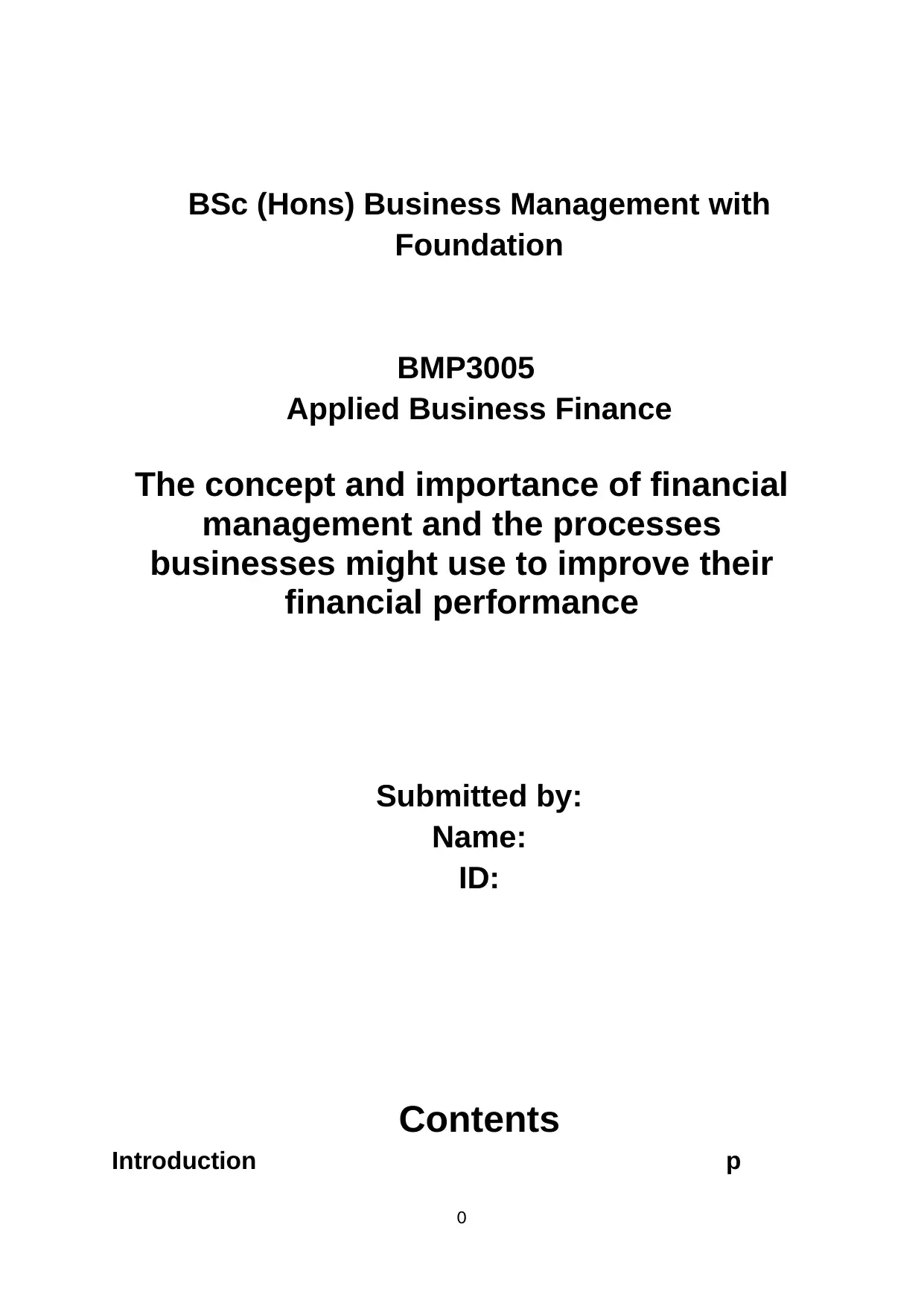
BSc (Hons) Business Management with
Foundation
BMP3005
Applied Business Finance
The concept and importance of financial
management and the processes
businesses might use to improve their
financial performance
Submitted by:
Name:
ID:
Contents
Introduction p
0
Foundation
BMP3005
Applied Business Finance
The concept and importance of financial
management and the processes
businesses might use to improve their
financial performance
Submitted by:
Name:
ID:
Contents
Introduction p
0
Paraphrase This Document
Need a fresh take? Get an instant paraphrase of this document with our AI Paraphraser
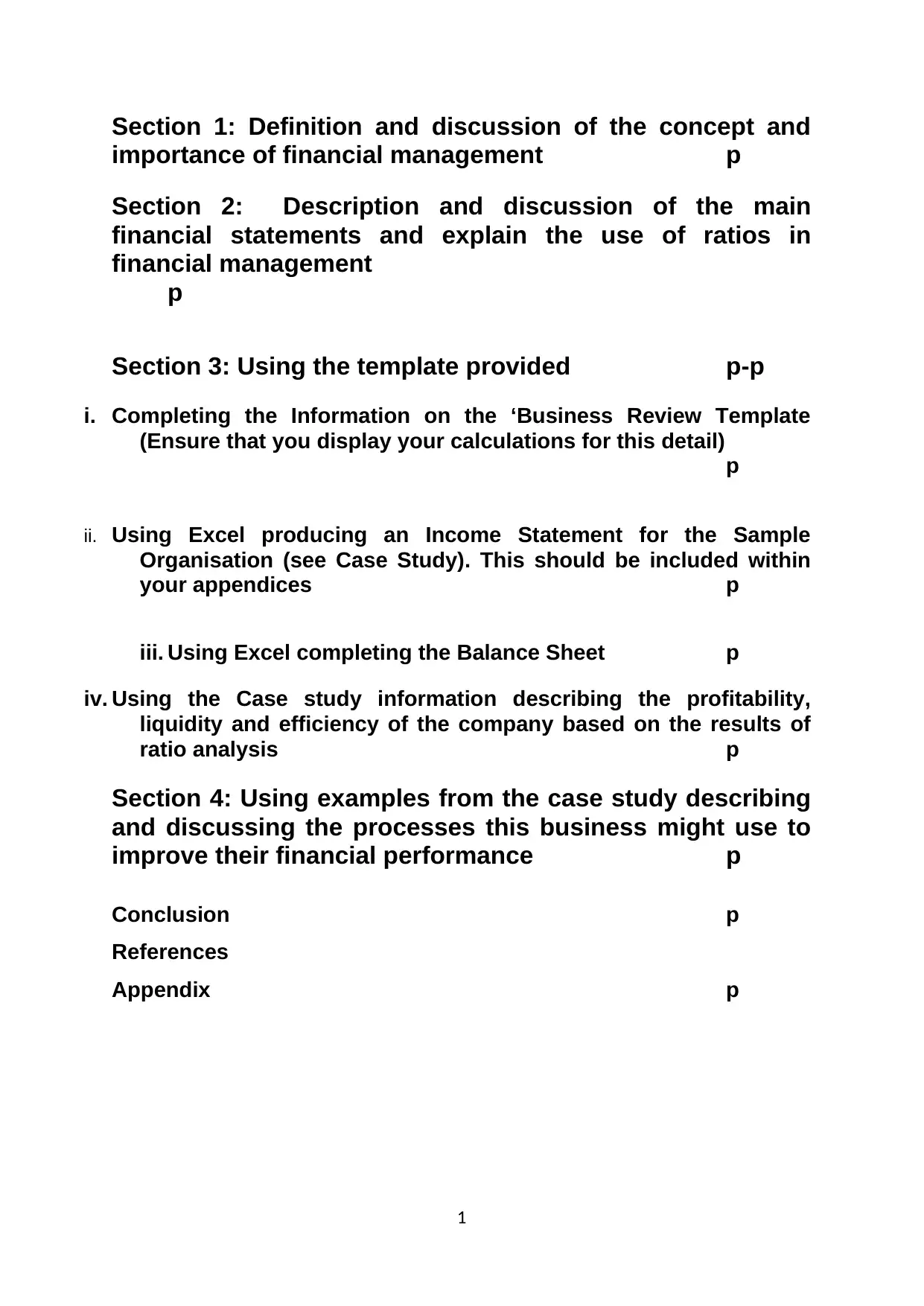
Section 1: Definition and discussion of the concept and
importance of financial management p
Section 2: Description and discussion of the main
financial statements and explain the use of ratios in
financial management
p
Section 3: Using the template provided p-p
i. Completing the Information on the ‘Business Review Template
(Ensure that you display your calculations for this detail)
p
ii. Using Excel producing an Income Statement for the Sample
Organisation (see Case Study). This should be included within
your appendices p
iii. Using Excel completing the Balance Sheet p
iv. Using the Case study information describing the profitability,
liquidity and efficiency of the company based on the results of
ratio analysis p
Section 4: Using examples from the case study describing
and discussing the processes this business might use to
improve their financial performance p
Conclusion p
References
Appendix p
1
importance of financial management p
Section 2: Description and discussion of the main
financial statements and explain the use of ratios in
financial management
p
Section 3: Using the template provided p-p
i. Completing the Information on the ‘Business Review Template
(Ensure that you display your calculations for this detail)
p
ii. Using Excel producing an Income Statement for the Sample
Organisation (see Case Study). This should be included within
your appendices p
iii. Using Excel completing the Balance Sheet p
iv. Using the Case study information describing the profitability,
liquidity and efficiency of the company based on the results of
ratio analysis p
Section 4: Using examples from the case study describing
and discussing the processes this business might use to
improve their financial performance p
Conclusion p
References
Appendix p
1
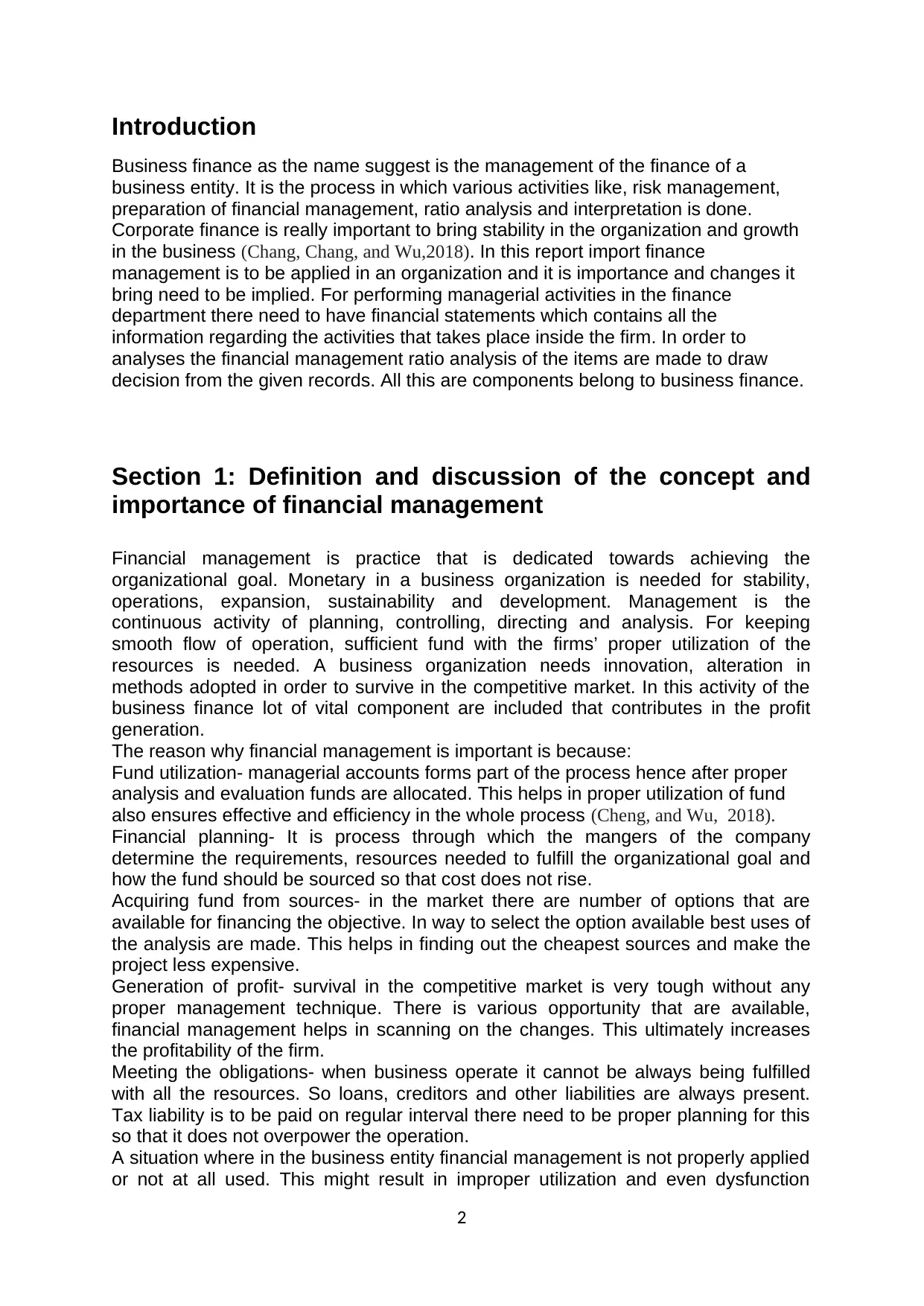
Introduction
Business finance as the name suggest is the management of the finance of a
business entity. It is the process in which various activities like, risk management,
preparation of financial management, ratio analysis and interpretation is done.
Corporate finance is really important to bring stability in the organization and growth
in the business (Chang, Chang, and Wu,2018). In this report import finance
management is to be applied in an organization and it is importance and changes it
bring need to be implied. For performing managerial activities in the finance
department there need to have financial statements which contains all the
information regarding the activities that takes place inside the firm. In order to
analyses the financial management ratio analysis of the items are made to draw
decision from the given records. All this are components belong to business finance.
Section 1: Definition and discussion of the concept and
importance of financial management
Financial management is practice that is dedicated towards achieving the
organizational goal. Monetary in a business organization is needed for stability,
operations, expansion, sustainability and development. Management is the
continuous activity of planning, controlling, directing and analysis. For keeping
smooth flow of operation, sufficient fund with the firms’ proper utilization of the
resources is needed. A business organization needs innovation, alteration in
methods adopted in order to survive in the competitive market. In this activity of the
business finance lot of vital component are included that contributes in the profit
generation.
The reason why financial management is important is because:
Fund utilization- managerial accounts forms part of the process hence after proper
analysis and evaluation funds are allocated. This helps in proper utilization of fund
also ensures effective and efficiency in the whole process (Cheng, and Wu, 2018).
Financial planning- It is process through which the mangers of the company
determine the requirements, resources needed to fulfill the organizational goal and
how the fund should be sourced so that cost does not rise.
Acquiring fund from sources- in the market there are number of options that are
available for financing the objective. In way to select the option available best uses of
the analysis are made. This helps in finding out the cheapest sources and make the
project less expensive.
Generation of profit- survival in the competitive market is very tough without any
proper management technique. There is various opportunity that are available,
financial management helps in scanning on the changes. This ultimately increases
the profitability of the firm.
Meeting the obligations- when business operate it cannot be always being fulfilled
with all the resources. So loans, creditors and other liabilities are always present.
Tax liability is to be paid on regular interval there need to be proper planning for this
so that it does not overpower the operation.
A situation where in the business entity financial management is not properly applied
or not at all used. This might result in improper utilization and even dysfunction
2
Business finance as the name suggest is the management of the finance of a
business entity. It is the process in which various activities like, risk management,
preparation of financial management, ratio analysis and interpretation is done.
Corporate finance is really important to bring stability in the organization and growth
in the business (Chang, Chang, and Wu,2018). In this report import finance
management is to be applied in an organization and it is importance and changes it
bring need to be implied. For performing managerial activities in the finance
department there need to have financial statements which contains all the
information regarding the activities that takes place inside the firm. In order to
analyses the financial management ratio analysis of the items are made to draw
decision from the given records. All this are components belong to business finance.
Section 1: Definition and discussion of the concept and
importance of financial management
Financial management is practice that is dedicated towards achieving the
organizational goal. Monetary in a business organization is needed for stability,
operations, expansion, sustainability and development. Management is the
continuous activity of planning, controlling, directing and analysis. For keeping
smooth flow of operation, sufficient fund with the firms’ proper utilization of the
resources is needed. A business organization needs innovation, alteration in
methods adopted in order to survive in the competitive market. In this activity of the
business finance lot of vital component are included that contributes in the profit
generation.
The reason why financial management is important is because:
Fund utilization- managerial accounts forms part of the process hence after proper
analysis and evaluation funds are allocated. This helps in proper utilization of fund
also ensures effective and efficiency in the whole process (Cheng, and Wu, 2018).
Financial planning- It is process through which the mangers of the company
determine the requirements, resources needed to fulfill the organizational goal and
how the fund should be sourced so that cost does not rise.
Acquiring fund from sources- in the market there are number of options that are
available for financing the objective. In way to select the option available best uses of
the analysis are made. This helps in finding out the cheapest sources and make the
project less expensive.
Generation of profit- survival in the competitive market is very tough without any
proper management technique. There is various opportunity that are available,
financial management helps in scanning on the changes. This ultimately increases
the profitability of the firm.
Meeting the obligations- when business operate it cannot be always being fulfilled
with all the resources. So loans, creditors and other liabilities are always present.
Tax liability is to be paid on regular interval there need to be proper planning for this
so that it does not overpower the operation.
A situation where in the business entity financial management is not properly applied
or not at all used. This might result in improper utilization and even dysfunction
2
⊘ This is a preview!⊘
Do you want full access?
Subscribe today to unlock all pages.

Trusted by 1+ million students worldwide
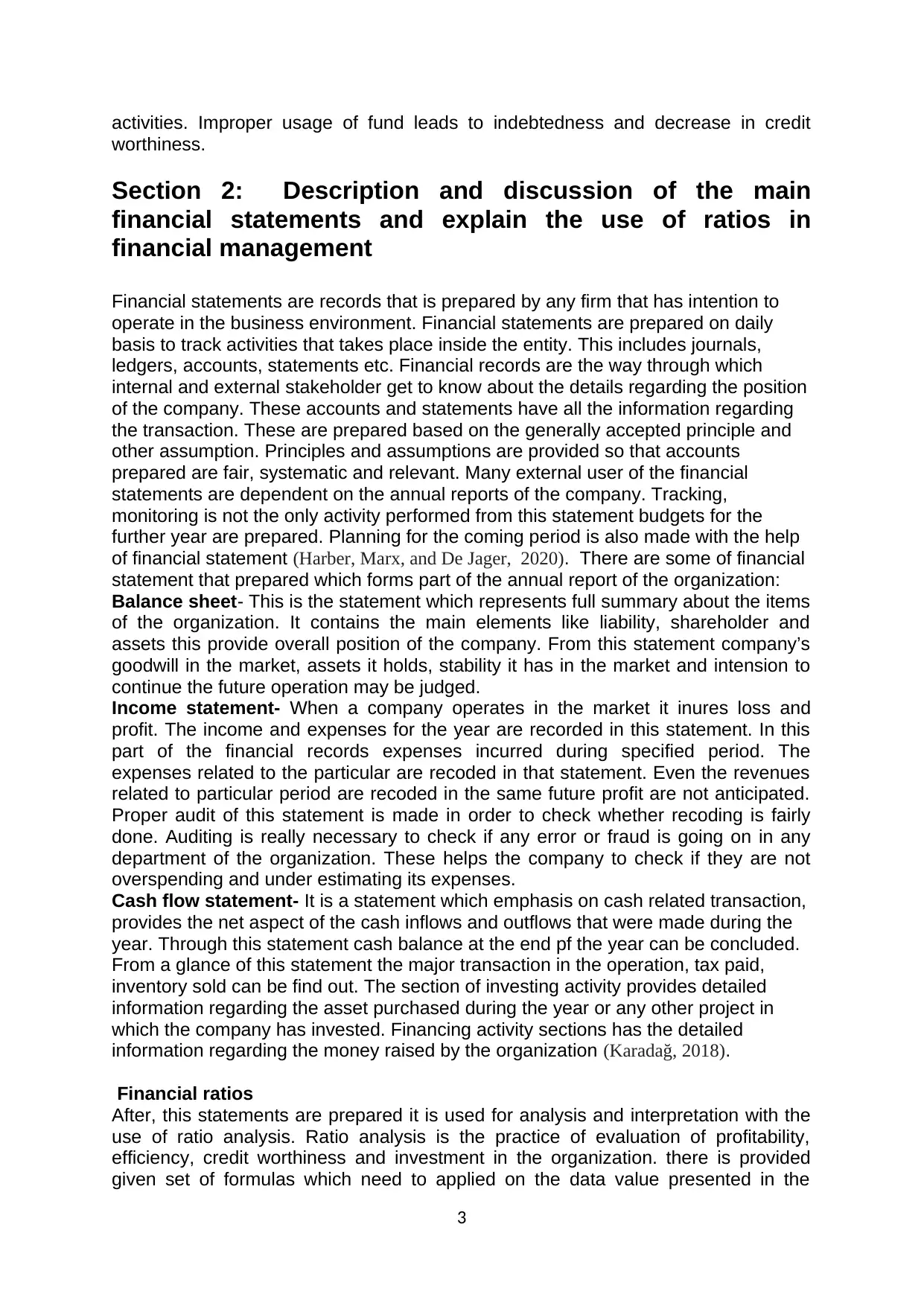
activities. Improper usage of fund leads to indebtedness and decrease in credit
worthiness.
Section 2: Description and discussion of the main
financial statements and explain the use of ratios in
financial management
Financial statements are records that is prepared by any firm that has intention to
operate in the business environment. Financial statements are prepared on daily
basis to track activities that takes place inside the entity. This includes journals,
ledgers, accounts, statements etc. Financial records are the way through which
internal and external stakeholder get to know about the details regarding the position
of the company. These accounts and statements have all the information regarding
the transaction. These are prepared based on the generally accepted principle and
other assumption. Principles and assumptions are provided so that accounts
prepared are fair, systematic and relevant. Many external user of the financial
statements are dependent on the annual reports of the company. Tracking,
monitoring is not the only activity performed from this statement budgets for the
further year are prepared. Planning for the coming period is also made with the help
of financial statement (Harber, Marx, and De Jager, 2020). There are some of financial
statement that prepared which forms part of the annual report of the organization:
Balance sheet- This is the statement which represents full summary about the items
of the organization. It contains the main elements like liability, shareholder and
assets this provide overall position of the company. From this statement company’s
goodwill in the market, assets it holds, stability it has in the market and intension to
continue the future operation may be judged.
Income statement- When a company operates in the market it inures loss and
profit. The income and expenses for the year are recorded in this statement. In this
part of the financial records expenses incurred during specified period. The
expenses related to the particular are recoded in that statement. Even the revenues
related to particular period are recoded in the same future profit are not anticipated.
Proper audit of this statement is made in order to check whether recoding is fairly
done. Auditing is really necessary to check if any error or fraud is going on in any
department of the organization. These helps the company to check if they are not
overspending and under estimating its expenses.
Cash flow statement- It is a statement which emphasis on cash related transaction,
provides the net aspect of the cash inflows and outflows that were made during the
year. Through this statement cash balance at the end pf the year can be concluded.
From a glance of this statement the major transaction in the operation, tax paid,
inventory sold can be find out. The section of investing activity provides detailed
information regarding the asset purchased during the year or any other project in
which the company has invested. Financing activity sections has the detailed
information regarding the money raised by the organization (Karadağ, 2018).
Financial ratios
After, this statements are prepared it is used for analysis and interpretation with the
use of ratio analysis. Ratio analysis is the practice of evaluation of profitability,
efficiency, credit worthiness and investment in the organization. there is provided
given set of formulas which need to applied on the data value presented in the
3
worthiness.
Section 2: Description and discussion of the main
financial statements and explain the use of ratios in
financial management
Financial statements are records that is prepared by any firm that has intention to
operate in the business environment. Financial statements are prepared on daily
basis to track activities that takes place inside the entity. This includes journals,
ledgers, accounts, statements etc. Financial records are the way through which
internal and external stakeholder get to know about the details regarding the position
of the company. These accounts and statements have all the information regarding
the transaction. These are prepared based on the generally accepted principle and
other assumption. Principles and assumptions are provided so that accounts
prepared are fair, systematic and relevant. Many external user of the financial
statements are dependent on the annual reports of the company. Tracking,
monitoring is not the only activity performed from this statement budgets for the
further year are prepared. Planning for the coming period is also made with the help
of financial statement (Harber, Marx, and De Jager, 2020). There are some of financial
statement that prepared which forms part of the annual report of the organization:
Balance sheet- This is the statement which represents full summary about the items
of the organization. It contains the main elements like liability, shareholder and
assets this provide overall position of the company. From this statement company’s
goodwill in the market, assets it holds, stability it has in the market and intension to
continue the future operation may be judged.
Income statement- When a company operates in the market it inures loss and
profit. The income and expenses for the year are recorded in this statement. In this
part of the financial records expenses incurred during specified period. The
expenses related to the particular are recoded in that statement. Even the revenues
related to particular period are recoded in the same future profit are not anticipated.
Proper audit of this statement is made in order to check whether recoding is fairly
done. Auditing is really necessary to check if any error or fraud is going on in any
department of the organization. These helps the company to check if they are not
overspending and under estimating its expenses.
Cash flow statement- It is a statement which emphasis on cash related transaction,
provides the net aspect of the cash inflows and outflows that were made during the
year. Through this statement cash balance at the end pf the year can be concluded.
From a glance of this statement the major transaction in the operation, tax paid,
inventory sold can be find out. The section of investing activity provides detailed
information regarding the asset purchased during the year or any other project in
which the company has invested. Financing activity sections has the detailed
information regarding the money raised by the organization (Karadağ, 2018).
Financial ratios
After, this statements are prepared it is used for analysis and interpretation with the
use of ratio analysis. Ratio analysis is the practice of evaluation of profitability,
efficiency, credit worthiness and investment in the organization. there is provided
given set of formulas which need to applied on the data value presented in the
3
Paraphrase This Document
Need a fresh take? Get an instant paraphrase of this document with our AI Paraphraser
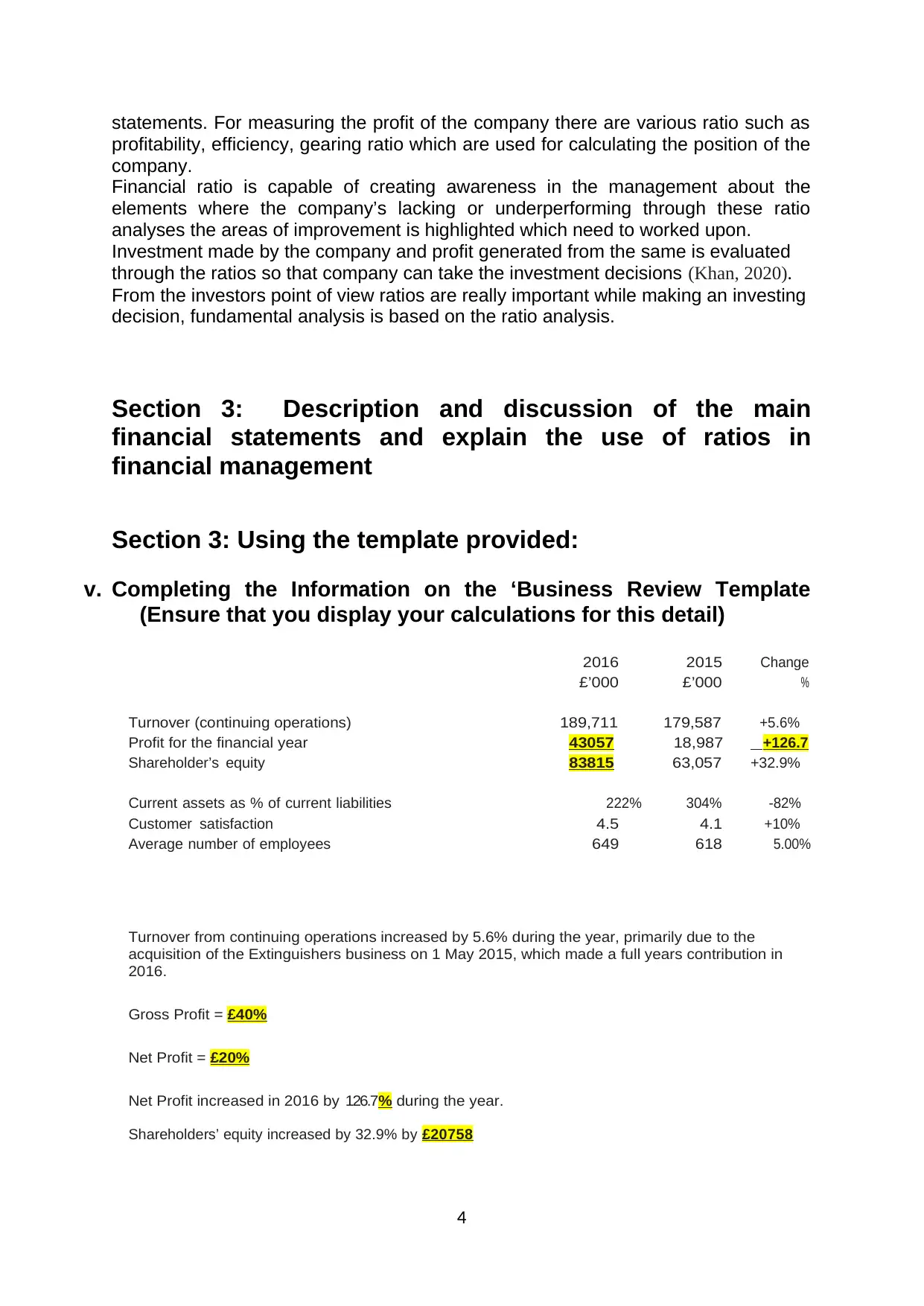
statements. For measuring the profit of the company there are various ratio such as
profitability, efficiency, gearing ratio which are used for calculating the position of the
company.
Financial ratio is capable of creating awareness in the management about the
elements where the company’s lacking or underperforming through these ratio
analyses the areas of improvement is highlighted which need to worked upon.
Investment made by the company and profit generated from the same is evaluated
through the ratios so that company can take the investment decisions (Khan, 2020).
From the investors point of view ratios are really important while making an investing
decision, fundamental analysis is based on the ratio analysis.
Section 3: Description and discussion of the main
financial statements and explain the use of ratios in
financial management
Section 3: Using the template provided:
v. Completing the Information on the ‘Business Review Template
(Ensure that you display your calculations for this detail)
2016
£’000
2015
£’000
Change
%
Turnover (continuing operations) 189,711 179,587 +5.6%
Profit for the financial year 43057 18,987 +126.7
Shareholder’s equity 83815 63,057 +32.9%
Current assets as % of current liabilities 222% 304% -82%
Customer satisfaction 4.5 4.1 +10%
Average number of employees 649 618 5.00%
Turnover from continuing operations increased by 5.6% during the year, primarily due to the
acquisition of the Extinguishers business on 1 May 2015, which made a full years contribution in
2016.
Gross Profit = £40%
Net Profit = £20%
Net Profit increased in 2016 by 126.7% during the year.
Shareholders’ equity increased by 32.9% by £20758
4
profitability, efficiency, gearing ratio which are used for calculating the position of the
company.
Financial ratio is capable of creating awareness in the management about the
elements where the company’s lacking or underperforming through these ratio
analyses the areas of improvement is highlighted which need to worked upon.
Investment made by the company and profit generated from the same is evaluated
through the ratios so that company can take the investment decisions (Khan, 2020).
From the investors point of view ratios are really important while making an investing
decision, fundamental analysis is based on the ratio analysis.
Section 3: Description and discussion of the main
financial statements and explain the use of ratios in
financial management
Section 3: Using the template provided:
v. Completing the Information on the ‘Business Review Template
(Ensure that you display your calculations for this detail)
2016
£’000
2015
£’000
Change
%
Turnover (continuing operations) 189,711 179,587 +5.6%
Profit for the financial year 43057 18,987 +126.7
Shareholder’s equity 83815 63,057 +32.9%
Current assets as % of current liabilities 222% 304% -82%
Customer satisfaction 4.5 4.1 +10%
Average number of employees 649 618 5.00%
Turnover from continuing operations increased by 5.6% during the year, primarily due to the
acquisition of the Extinguishers business on 1 May 2015, which made a full years contribution in
2016.
Gross Profit = £40%
Net Profit = £20%
Net Profit increased in 2016 by 126.7% during the year.
Shareholders’ equity increased by 32.9% by £20758
4
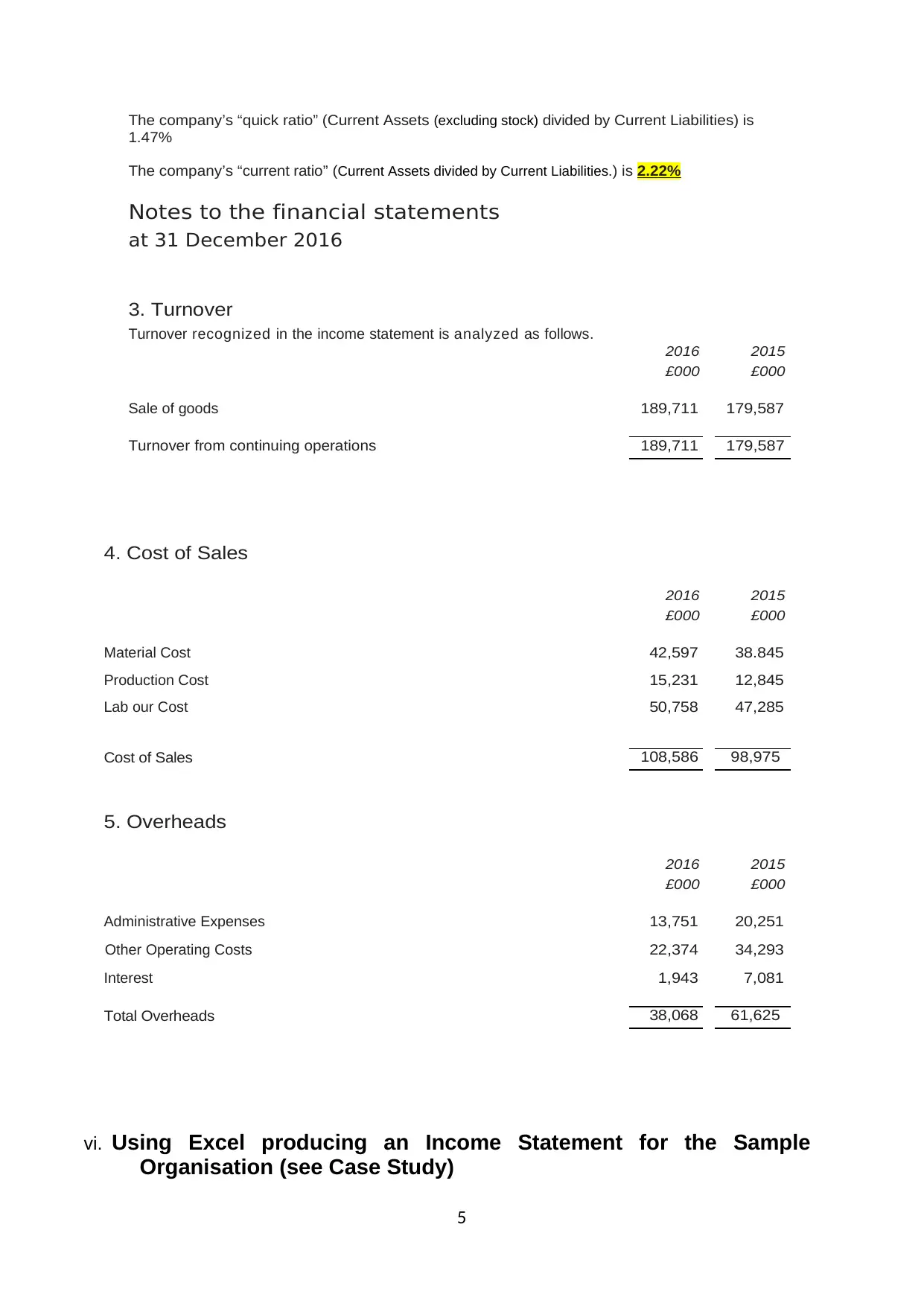
The company’s “quick ratio” (Current Assets (excluding stock) divided by Current Liabilities) is
1.47%
The company’s “current ratio” (Current Assets divided by Current Liabilities. ) is 2.22%
Notes to the financial statements
at 31 December 2016
3. Turnover
Turnover recognized in the income statement is analyzed as follows.
2016 2015
£000 £000
Sale of goods 189,711 179,587
Turnover from continuing operations 189,711 179,587
4. Cost of Sales
2016 2015
£000 £000
Material Cost 42,597 38.845
Production Cost 15,231 12,845
Lab our Cost 50,758 47,285
Cost of Sales 108,586 98,975
5. Overheads
2016 2015
£000 £000
Administrative Expenses 13,751 20,251
Other Operating Costs 22,374 34,293
Interest 1,943 7,081
Total Overheads 38,068 61,625
vi. Using Excel producing an Income Statement for the Sample
Organisation (see Case Study)
5
1.47%
The company’s “current ratio” (Current Assets divided by Current Liabilities. ) is 2.22%
Notes to the financial statements
at 31 December 2016
3. Turnover
Turnover recognized in the income statement is analyzed as follows.
2016 2015
£000 £000
Sale of goods 189,711 179,587
Turnover from continuing operations 189,711 179,587
4. Cost of Sales
2016 2015
£000 £000
Material Cost 42,597 38.845
Production Cost 15,231 12,845
Lab our Cost 50,758 47,285
Cost of Sales 108,586 98,975
5. Overheads
2016 2015
£000 £000
Administrative Expenses 13,751 20,251
Other Operating Costs 22,374 34,293
Interest 1,943 7,081
Total Overheads 38,068 61,625
vi. Using Excel producing an Income Statement for the Sample
Organisation (see Case Study)
5
⊘ This is a preview!⊘
Do you want full access?
Subscribe today to unlock all pages.

Trusted by 1+ million students worldwide
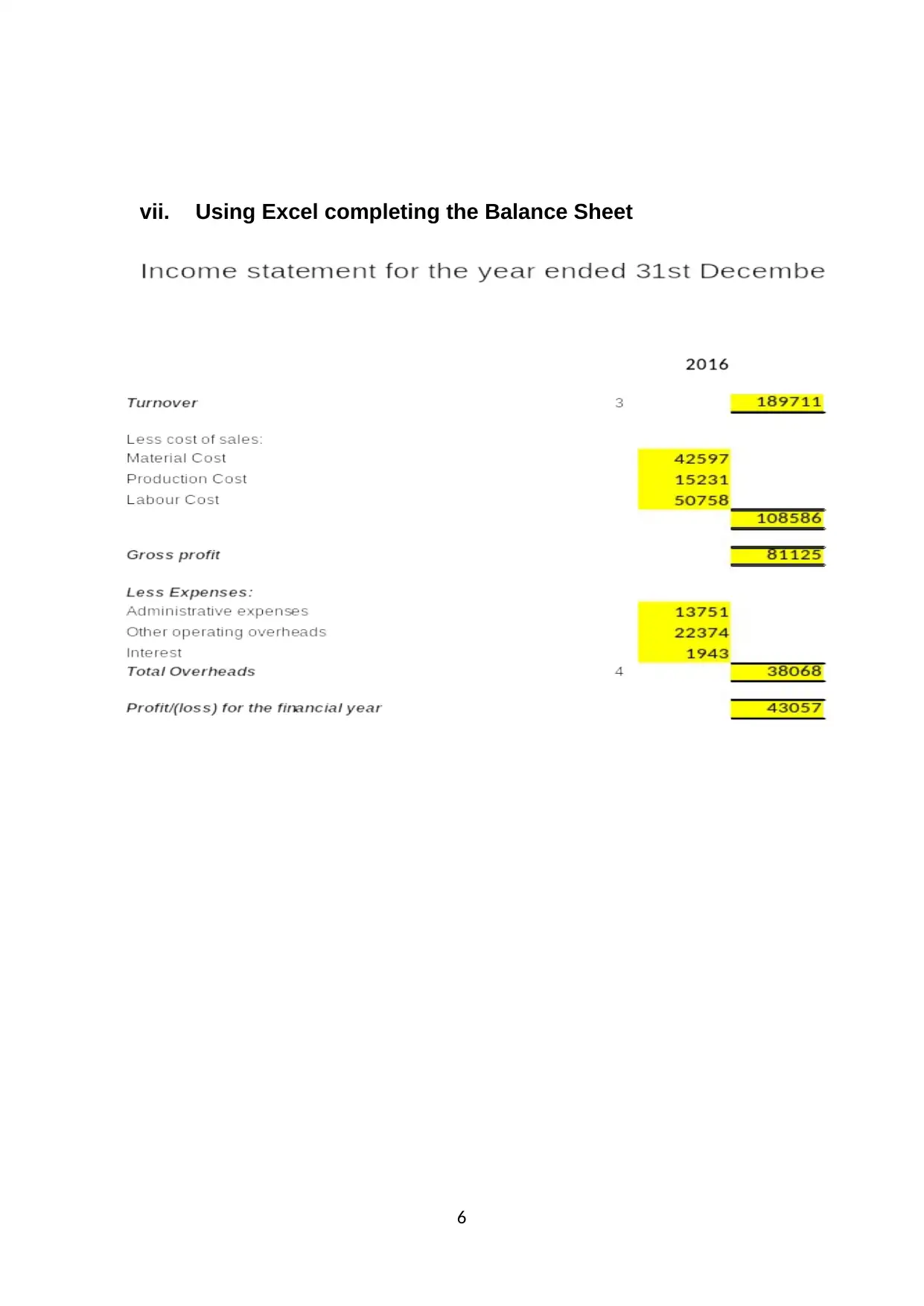
vii. Using Excel completing the Balance Sheet
6
6
Paraphrase This Document
Need a fresh take? Get an instant paraphrase of this document with our AI Paraphraser
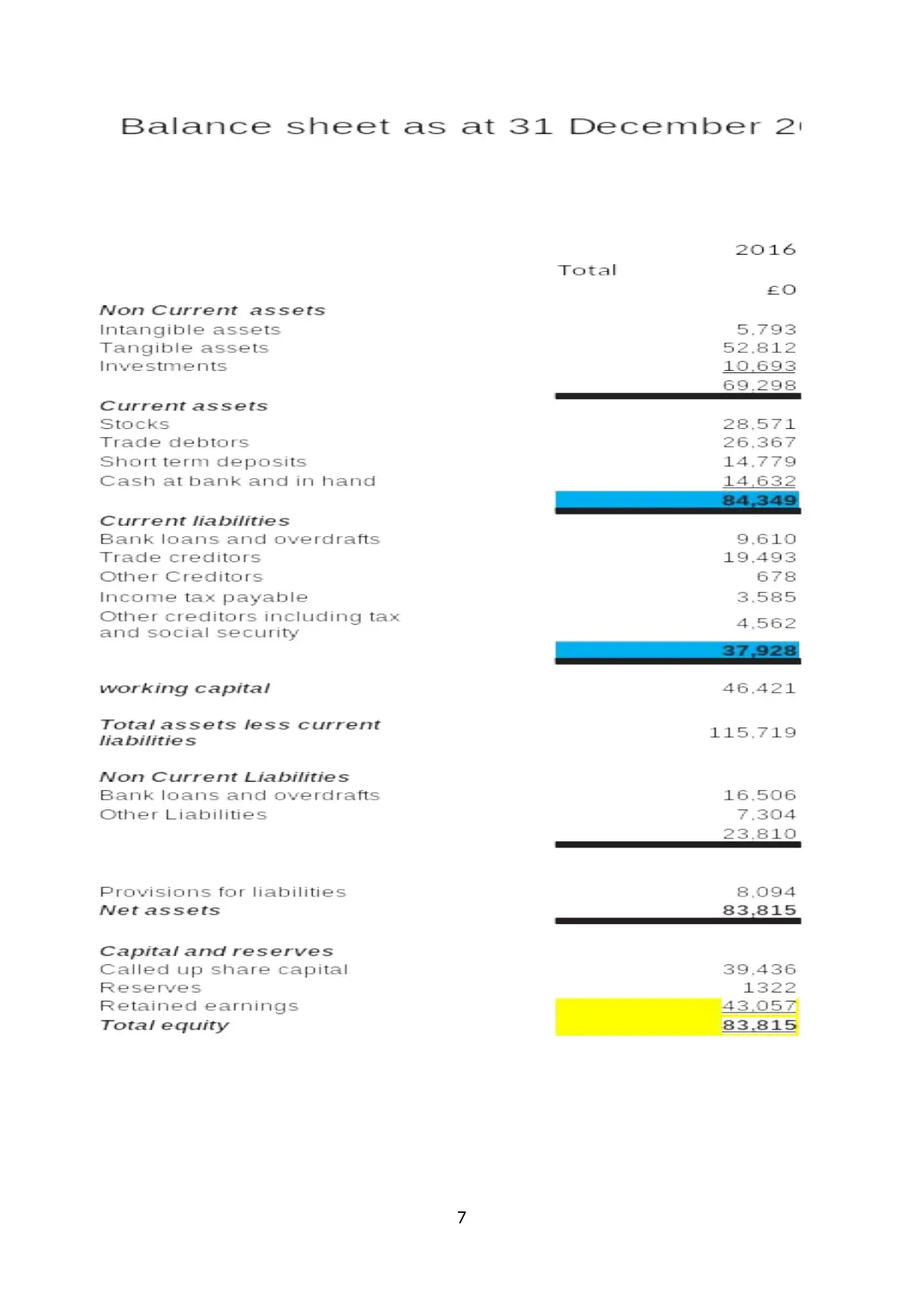
7
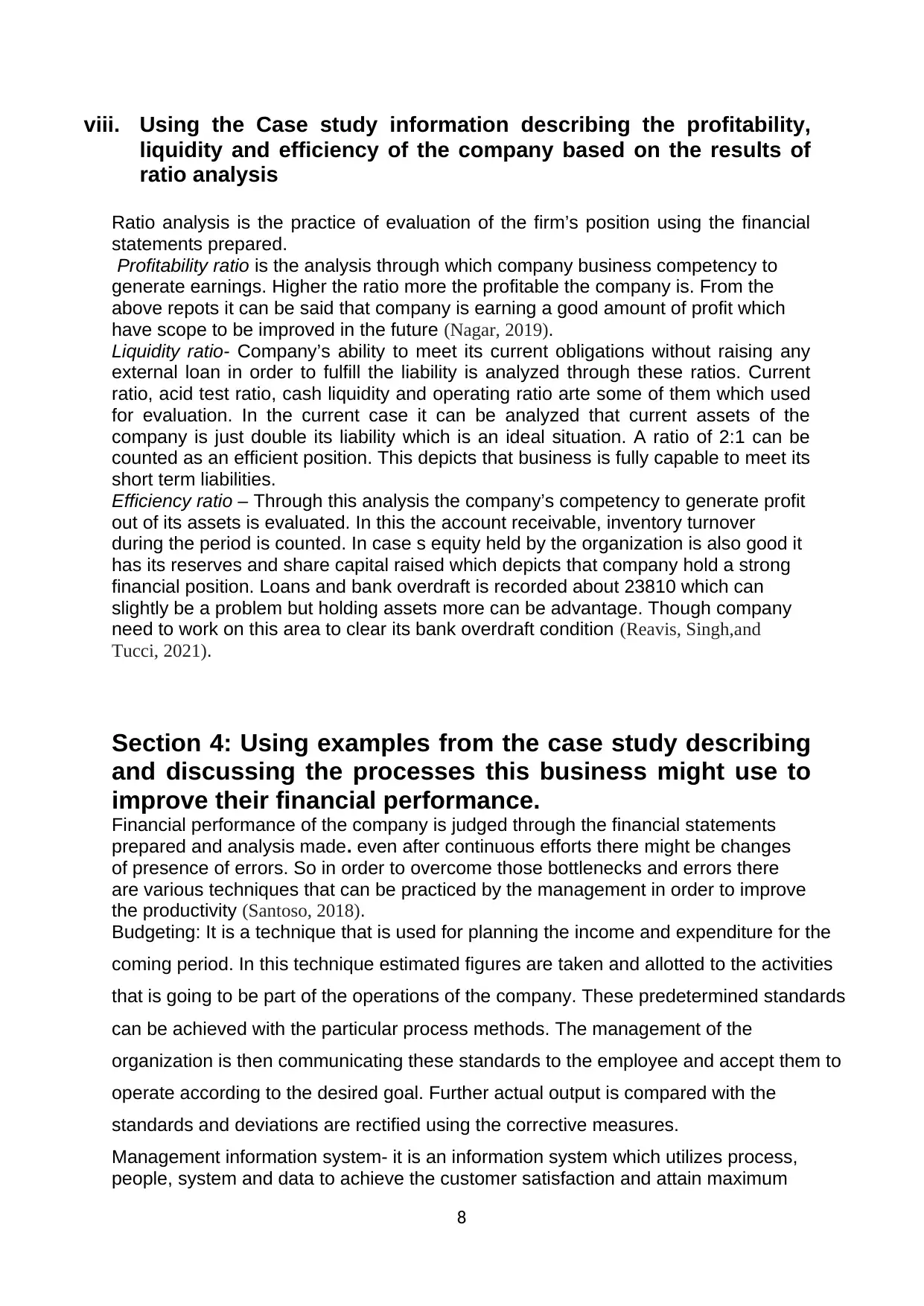
viii. Using the Case study information describing the profitability,
liquidity and efficiency of the company based on the results of
ratio analysis
Ratio analysis is the practice of evaluation of the firm’s position using the financial
statements prepared.
Profitability ratio is the analysis through which company business competency to
generate earnings. Higher the ratio more the profitable the company is. From the
above repots it can be said that company is earning a good amount of profit which
have scope to be improved in the future (Nagar, 2019).
Liquidity ratio- Company’s ability to meet its current obligations without raising any
external loan in order to fulfill the liability is analyzed through these ratios. Current
ratio, acid test ratio, cash liquidity and operating ratio arte some of them which used
for evaluation. In the current case it can be analyzed that current assets of the
company is just double its liability which is an ideal situation. A ratio of 2:1 can be
counted as an efficient position. This depicts that business is fully capable to meet its
short term liabilities.
Efficiency ratio – Through this analysis the company’s competency to generate profit
out of its assets is evaluated. In this the account receivable, inventory turnover
during the period is counted. In case s equity held by the organization is also good it
has its reserves and share capital raised which depicts that company hold a strong
financial position. Loans and bank overdraft is recorded about 23810 which can
slightly be a problem but holding assets more can be advantage. Though company
need to work on this area to clear its bank overdraft condition (Reavis, Singh,and
Tucci, 2021).
Section 4: Using examples from the case study describing
and discussing the processes this business might use to
improve their financial performance.
Financial performance of the company is judged through the financial statements
prepared and analysis made. even after continuous efforts there might be changes
of presence of errors. So in order to overcome those bottlenecks and errors there
are various techniques that can be practiced by the management in order to improve
the productivity (Santoso, 2018).
Budgeting: It is a technique that is used for planning the income and expenditure for the
coming period. In this technique estimated figures are taken and allotted to the activities
that is going to be part of the operations of the company. These predetermined standards
can be achieved with the particular process methods. The management of the
organization is then communicating these standards to the employee and accept them to
operate according to the desired goal. Further actual output is compared with the
standards and deviations are rectified using the corrective measures.
Management information system- it is an information system which utilizes process,
people, system and data to achieve the customer satisfaction and attain maximum
8
liquidity and efficiency of the company based on the results of
ratio analysis
Ratio analysis is the practice of evaluation of the firm’s position using the financial
statements prepared.
Profitability ratio is the analysis through which company business competency to
generate earnings. Higher the ratio more the profitable the company is. From the
above repots it can be said that company is earning a good amount of profit which
have scope to be improved in the future (Nagar, 2019).
Liquidity ratio- Company’s ability to meet its current obligations without raising any
external loan in order to fulfill the liability is analyzed through these ratios. Current
ratio, acid test ratio, cash liquidity and operating ratio arte some of them which used
for evaluation. In the current case it can be analyzed that current assets of the
company is just double its liability which is an ideal situation. A ratio of 2:1 can be
counted as an efficient position. This depicts that business is fully capable to meet its
short term liabilities.
Efficiency ratio – Through this analysis the company’s competency to generate profit
out of its assets is evaluated. In this the account receivable, inventory turnover
during the period is counted. In case s equity held by the organization is also good it
has its reserves and share capital raised which depicts that company hold a strong
financial position. Loans and bank overdraft is recorded about 23810 which can
slightly be a problem but holding assets more can be advantage. Though company
need to work on this area to clear its bank overdraft condition (Reavis, Singh,and
Tucci, 2021).
Section 4: Using examples from the case study describing
and discussing the processes this business might use to
improve their financial performance.
Financial performance of the company is judged through the financial statements
prepared and analysis made. even after continuous efforts there might be changes
of presence of errors. So in order to overcome those bottlenecks and errors there
are various techniques that can be practiced by the management in order to improve
the productivity (Santoso, 2018).
Budgeting: It is a technique that is used for planning the income and expenditure for the
coming period. In this technique estimated figures are taken and allotted to the activities
that is going to be part of the operations of the company. These predetermined standards
can be achieved with the particular process methods. The management of the
organization is then communicating these standards to the employee and accept them to
operate according to the desired goal. Further actual output is compared with the
standards and deviations are rectified using the corrective measures.
Management information system- it is an information system which utilizes process,
people, system and data to achieve the customer satisfaction and attain maximum
8
⊘ This is a preview!⊘
Do you want full access?
Subscribe today to unlock all pages.

Trusted by 1+ million students worldwide
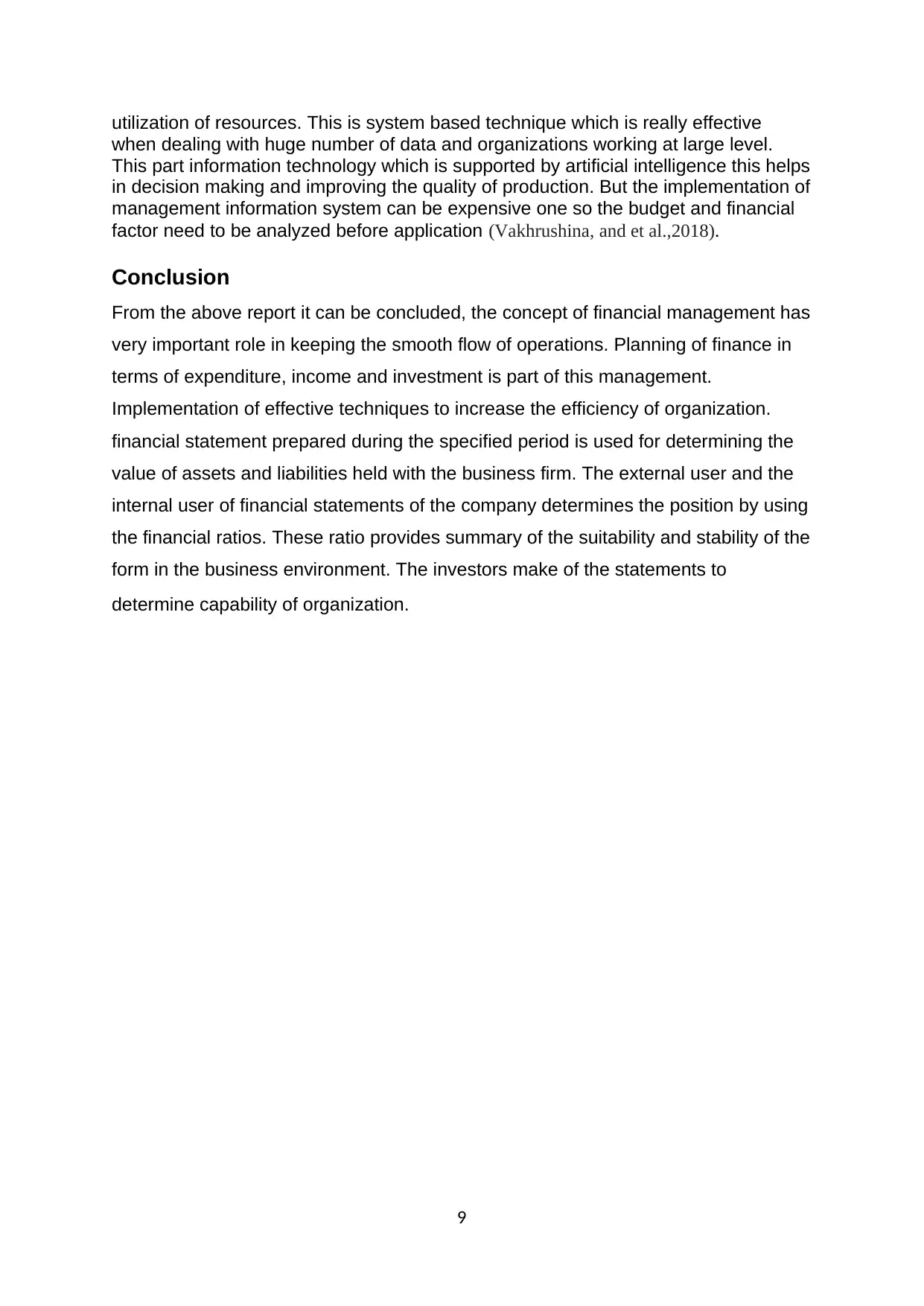
utilization of resources. This is system based technique which is really effective
when dealing with huge number of data and organizations working at large level.
This part information technology which is supported by artificial intelligence this helps
in decision making and improving the quality of production. But the implementation of
management information system can be expensive one so the budget and financial
factor need to be analyzed before application (Vakhrushina, and et al.,2018).
Conclusion
From the above report it can be concluded, the concept of financial management has
very important role in keeping the smooth flow of operations. Planning of finance in
terms of expenditure, income and investment is part of this management.
Implementation of effective techniques to increase the efficiency of organization.
financial statement prepared during the specified period is used for determining the
value of assets and liabilities held with the business firm. The external user and the
internal user of financial statements of the company determines the position by using
the financial ratios. These ratio provides summary of the suitability and stability of the
form in the business environment. The investors make of the statements to
determine capability of organization.
9
when dealing with huge number of data and organizations working at large level.
This part information technology which is supported by artificial intelligence this helps
in decision making and improving the quality of production. But the implementation of
management information system can be expensive one so the budget and financial
factor need to be analyzed before application (Vakhrushina, and et al.,2018).
Conclusion
From the above report it can be concluded, the concept of financial management has
very important role in keeping the smooth flow of operations. Planning of finance in
terms of expenditure, income and investment is part of this management.
Implementation of effective techniques to increase the efficiency of organization.
financial statement prepared during the specified period is used for determining the
value of assets and liabilities held with the business firm. The external user and the
internal user of financial statements of the company determines the position by using
the financial ratios. These ratio provides summary of the suitability and stability of the
form in the business environment. The investors make of the statements to
determine capability of organization.
9
Paraphrase This Document
Need a fresh take? Get an instant paraphrase of this document with our AI Paraphraser
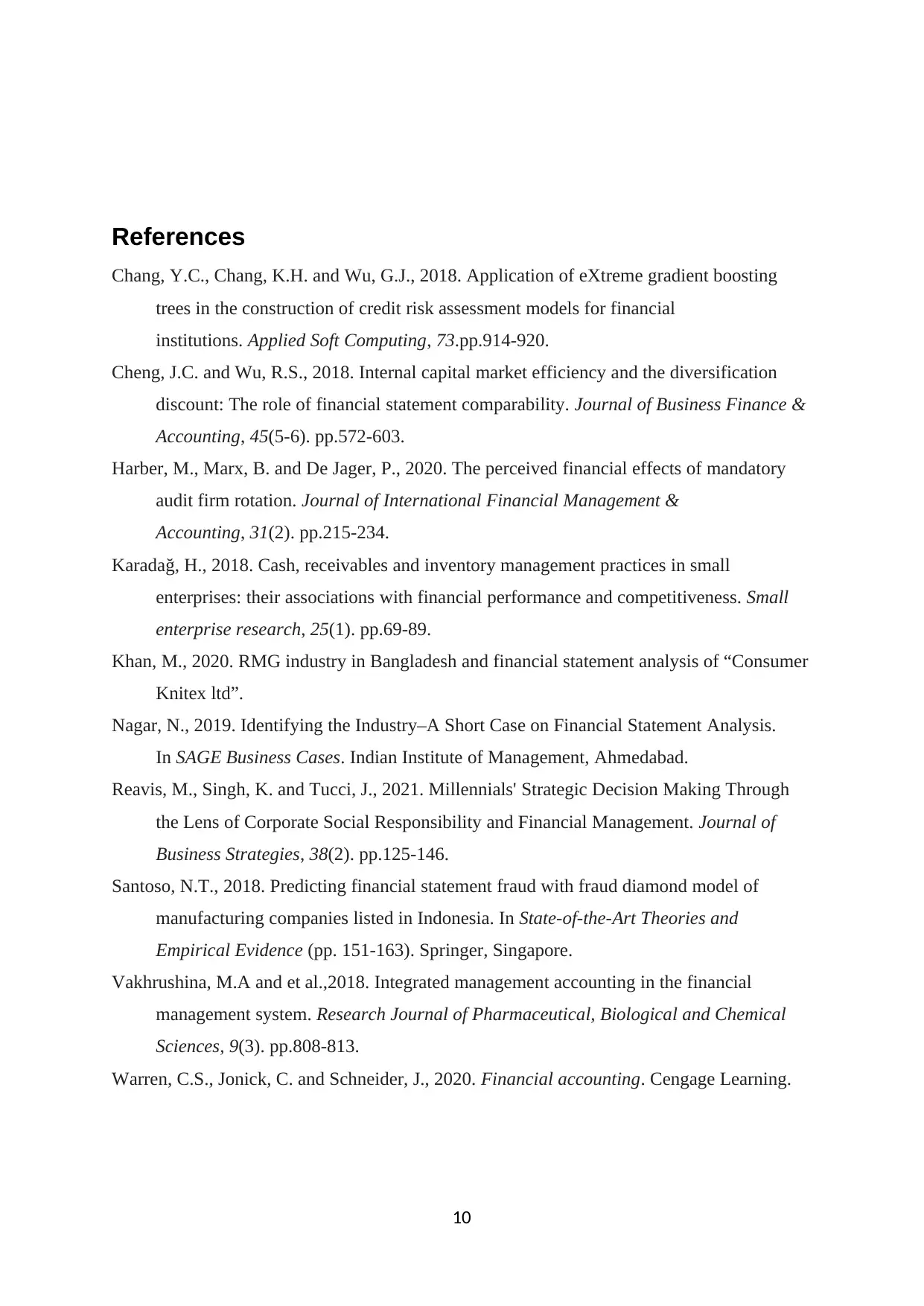
References
Chang, Y.C., Chang, K.H. and Wu, G.J., 2018. Application of eXtreme gradient boosting
trees in the construction of credit risk assessment models for financial
institutions. Applied Soft Computing, 73.pp.914-920.
Cheng, J.C. and Wu, R.S., 2018. Internal capital market efficiency and the diversification
discount: The role of financial statement comparability. Journal of Business Finance &
Accounting, 45(5-6). pp.572-603.
Harber, M., Marx, B. and De Jager, P., 2020. The perceived financial effects of mandatory
audit firm rotation. Journal of International Financial Management &
Accounting, 31(2). pp.215-234.
Karadağ, H., 2018. Cash, receivables and inventory management practices in small
enterprises: their associations with financial performance and competitiveness. Small
enterprise research, 25(1). pp.69-89.
Khan, M., 2020. RMG industry in Bangladesh and financial statement analysis of “Consumer
Knitex ltd”.
Nagar, N., 2019. Identifying the Industry–A Short Case on Financial Statement Analysis.
In SAGE Business Cases. Indian Institute of Management, Ahmedabad.
Reavis, M., Singh, K. and Tucci, J., 2021. Millennials' Strategic Decision Making Through
the Lens of Corporate Social Responsibility and Financial Management. Journal of
Business Strategies, 38(2). pp.125-146.
Santoso, N.T., 2018. Predicting financial statement fraud with fraud diamond model of
manufacturing companies listed in Indonesia. In State-of-the-Art Theories and
Empirical Evidence (pp. 151-163). Springer, Singapore.
Vakhrushina, M.A and et al.,2018. Integrated management accounting in the financial
management system. Research Journal of Pharmaceutical, Biological and Chemical
Sciences, 9(3). pp.808-813.
Warren, C.S., Jonick, C. and Schneider, J., 2020. Financial accounting. Cengage Learning.
10
Chang, Y.C., Chang, K.H. and Wu, G.J., 2018. Application of eXtreme gradient boosting
trees in the construction of credit risk assessment models for financial
institutions. Applied Soft Computing, 73.pp.914-920.
Cheng, J.C. and Wu, R.S., 2018. Internal capital market efficiency and the diversification
discount: The role of financial statement comparability. Journal of Business Finance &
Accounting, 45(5-6). pp.572-603.
Harber, M., Marx, B. and De Jager, P., 2020. The perceived financial effects of mandatory
audit firm rotation. Journal of International Financial Management &
Accounting, 31(2). pp.215-234.
Karadağ, H., 2018. Cash, receivables and inventory management practices in small
enterprises: their associations with financial performance and competitiveness. Small
enterprise research, 25(1). pp.69-89.
Khan, M., 2020. RMG industry in Bangladesh and financial statement analysis of “Consumer
Knitex ltd”.
Nagar, N., 2019. Identifying the Industry–A Short Case on Financial Statement Analysis.
In SAGE Business Cases. Indian Institute of Management, Ahmedabad.
Reavis, M., Singh, K. and Tucci, J., 2021. Millennials' Strategic Decision Making Through
the Lens of Corporate Social Responsibility and Financial Management. Journal of
Business Strategies, 38(2). pp.125-146.
Santoso, N.T., 2018. Predicting financial statement fraud with fraud diamond model of
manufacturing companies listed in Indonesia. In State-of-the-Art Theories and
Empirical Evidence (pp. 151-163). Springer, Singapore.
Vakhrushina, M.A and et al.,2018. Integrated management accounting in the financial
management system. Research Journal of Pharmaceutical, Biological and Chemical
Sciences, 9(3). pp.808-813.
Warren, C.S., Jonick, C. and Schneider, J., 2020. Financial accounting. Cengage Learning.
10
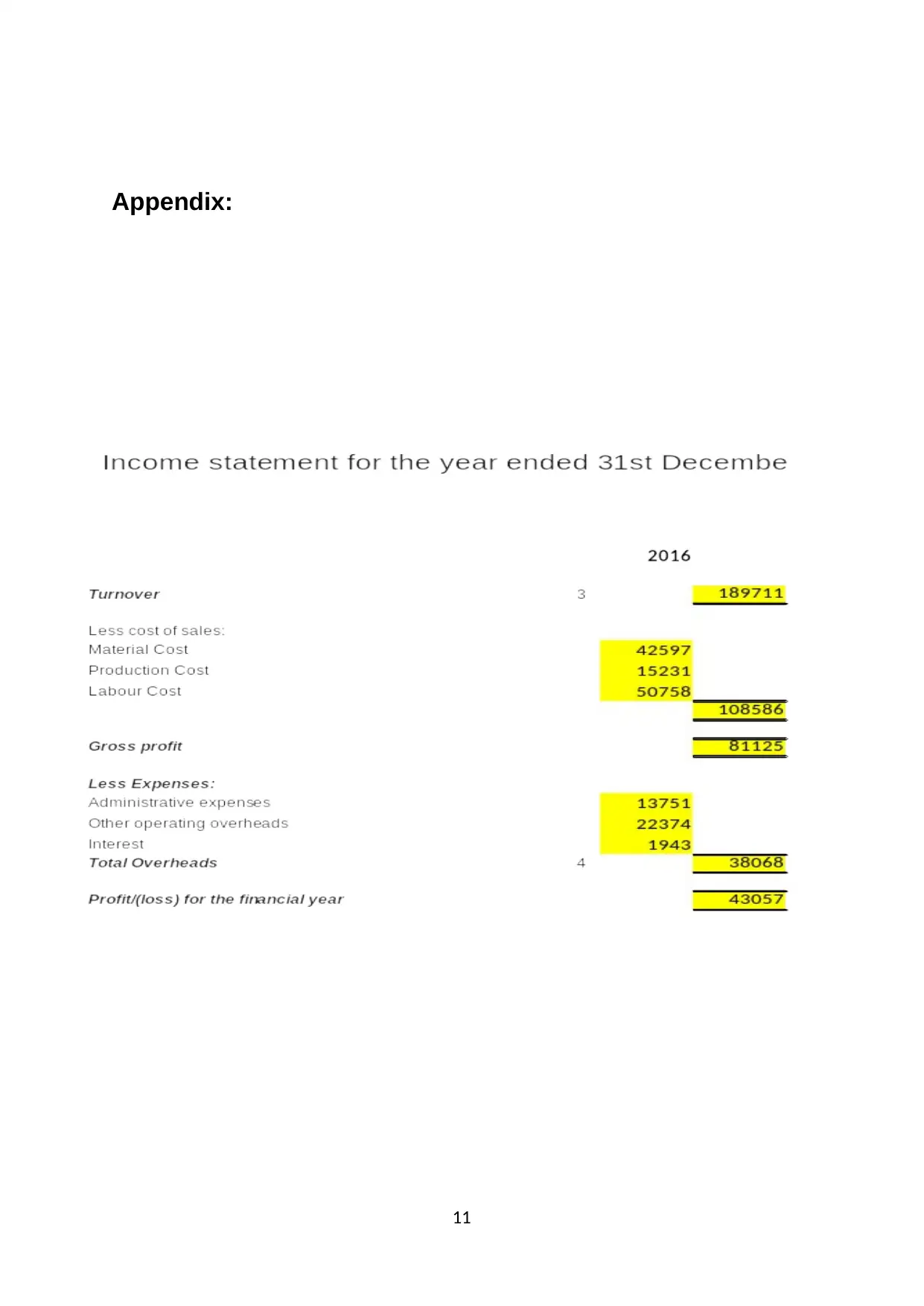
Appendix:
11
11
⊘ This is a preview!⊘
Do you want full access?
Subscribe today to unlock all pages.

Trusted by 1+ million students worldwide
1 out of 12
Related Documents
Your All-in-One AI-Powered Toolkit for Academic Success.
+13062052269
info@desklib.com
Available 24*7 on WhatsApp / Email
![[object Object]](/_next/static/media/star-bottom.7253800d.svg)
Unlock your academic potential
Copyright © 2020–2025 A2Z Services. All Rights Reserved. Developed and managed by ZUCOL.




